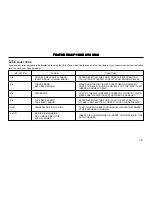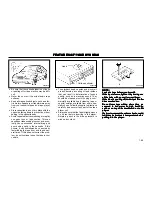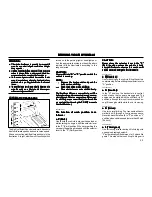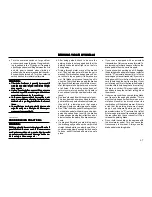
DRIVING YOUR HYUNDAI
DRIVING YOUR HYUNDAI
DRIVING YOUR HYUNDAI
DRIVING YOUR HYUNDAI
DRIVING YOUR HYUNDAI
2- 7
o After being parked, check to be sure the
parking brake is not engaged and that the
parking brake indicator light is out before
driving away.
o Driving through water may get the brakes
wet. They can also get wet when the car is
washed. Wet brakes can be dangerous! Your
car will not stop as quickly if the brakes are
wet. Wet brakes may cause the car to pull to
one side. To dry the brakes, apply the brakes
lightly until the braking action returns to nor-
mal, taking care to keep the car under control
at all times. If the braking action does not
return to normal, stop as soon as it is safe to
do so and call your Hyundai dealer for assis-
tance.
o Don’t coast down hills with the car out of gear.
This is extremely hazardous. Keep the car in
gear at all times, use the brakes to slow down,
then shift to a lower gear so that engine
braking will help you maintain a safe speed.
o Don’t “ride” the brake pedal. Resting your foot
on the brake pedal while driving can be dan-
gerous because it can result in the brakes
overheating and losing their effectiveness. It
also increases the wear of the brake compo-
nents.
o If a tire goes flat while you are driving, apply
the brakes gently and keep the car pointed
straight ahead while you slow down. When
you are moving slowly enough for it to be safe
to do so, pull off the road and stop in a safe
place.
C130A01A-AAT
GOOD BRAKING PRACTICES
GOOD BRAKING PRACTICES
GOOD BRAKING PRACTICES
GOOD BRAKING PRACTICES
GOOD BRAKING PRACTICES
WARNING:
WARNING:
WARNING:
WARNING:
WARNING:
Nothing should be carried on top of the shelf
Nothing should be carried on top of the shelf
Nothing should be carried on top of the shelf
Nothing should be carried on top of the shelf
Nothing should be carried on top of the shelf
panel behind the rear seat. If there were an
panel behind the rear seat. If there were an
panel behind the rear seat. If there were an
panel behind the rear seat. If there were an
panel behind the rear seat. If there were an
accident or a sudden stop, such objects could
accident or a sudden stop, such objects could
accident or a sudden stop, such objects could
accident or a sudden stop, such objects could
accident or a sudden stop, such objects could
move forward and cause damage to the ve-
move forward and cause damage to the ve-
move forward and cause damage to the ve-
move forward and cause damage to the ve-
move forward and cause damage to the ve-
hicle or injure the occupants.
hicle or injure the occupants.
hicle or injure the occupants.
hicle or injure the occupants.
hicle or injure the occupants.
o Turn the overdrive switch on for good fuel
economy and smooth driving. If engine brak-
ing is needed in the “D” range or if repeated
upshifting and downshifting between the 3rd
and 4th gear is needed when climbing a
gentle slope, it is recommended that the over-
drive switch be turned off. Turn the overdrive
switch back on immediately afterward.
WARNING:
WARNING:
WARNING:
WARNING:
WARNING:
o
o
o
o
o The risk of rollover is greatly increased if
The risk of rollover is greatly increased if
The risk of rollover is greatly increased if
The risk of rollover is greatly increased if
The risk of rollover is greatly increased if
you lose control of your vehicle at high-
you lose control of your vehicle at high-
you lose control of your vehicle at high-
you lose control of your vehicle at high-
you lose control of your vehicle at high-
way speeds.
way speeds.
way speeds.
way speeds.
way speeds.
o
o
o
o
o Loss of control often occurs if two or more
Loss of control often occurs if two or more
Loss of control often occurs if two or more
Loss of control often occurs if two or more
Loss of control often occurs if two or more
wheels drop off the roadway and the driver
wheels drop off the roadway and the driver
wheels drop off the roadway and the driver
wheels drop off the roadway and the driver
wheels drop off the roadway and the driver
oversteers to reenter the roadway.
oversteers to reenter the roadway.
oversteers to reenter the roadway.
oversteers to reenter the roadway.
oversteers to reenter the roadway.
o
o
o
o
o In the event your vehicle leaves the road-
In the event your vehicle leaves the road-
In the event your vehicle leaves the road-
In the event your vehicle leaves the road-
In the event your vehicle leaves the road-
way, do not steer sharply. Instead, slow
way, do not steer sharply. Instead, slow
way, do not steer sharply. Instead, slow
way, do not steer sharply. Instead, slow
way, do not steer sharply. Instead, slow
down before pulling back into the travel
down before pulling back into the travel
down before pulling back into the travel
down before pulling back into the travel
down before pulling back into the travel
lanes.
lanes.
lanes.
lanes.
lanes.
o
o
o
o
o In a collision crash, an unbelted person is
In a collision crash, an unbelted person is
In a collision crash, an unbelted person is
In a collision crash, an unbelted person is
In a collision crash, an unbelted person is
significantly more likely to die than a per-
significantly more likely to die than a per-
significantly more likely to die than a per-
significantly more likely to die than a per-
significantly more likely to die than a per-
son wearing a seatbelt.
son wearing a seatbelt.
son wearing a seatbelt.
son wearing a seatbelt.
son wearing a seatbelt.
o If your car is equipped with an automatic
transaxle, don’t let your car creep forward. To
avoid creeping forward, keep your foot on the
brake pedal when the car is stopped.
o Use caution when parking on a hill. Engage
the parking brake and place the gear selector
lever in “P” (automatic transaxle) or in first or
reverse gear (manual transaxle). If your car is
facing downhill, turn the front wheels into the
curb to help keep the car from rolling. If your
car is facing uphill, turn the front wheels away
from the curb to help keep the car from rolling.
If there is no curb or if it is required by other
conditions to keep the car from rolling, block
the wheels.
o Under some conditions your parking brake
can freeze in the engaged position. This is
most likely to happen when there is an accu-
mulation of snow or ice around or near the
rear brakes or if the brakes are wet. If there is
a risk that the parking brake may freeze,
apply it only temporarily while you put the
gear selector lever in “P” (automatic) or in first
or reverse gear (manual transaxle) and block
the rear wheels so the car cannot roll. Then
release the parking brake.
o Do not hold the vehicle on the upgrade with
the accelerator pedal. This can cause the
transmission to overheat. Always use the
brake pedal or parking brake.
Содержание 2001 Elantra
Страница 1: ...D R I V I N G IS B E L I E V I N G 2001 ...






























